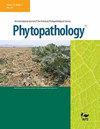Ravinder K Goyal, Joseph P M Hui, Jeffrey Ranches, Roumiana Stefanova, Alysson Jones, Arjun H Banskota, Ian Burton, Bianyun Yu, Fabrice Berrue, Albert Hannig, Shawn Clark, Syama Chatterton, Sangeeta Dhaubhadel, Junzeng Zhang
求助PDF
{"title":"Untargeted Metabolomic Analysis Reveals a Potential Role of Saponins in the Partial Resistance of Pea (<i>Pisum sativum</i>) Against a Root Rot Pathogen, <i>Aphanomyces euteiches</i>.","authors":"Ravinder K Goyal, Joseph P M Hui, Jeffrey Ranches, Roumiana Stefanova, Alysson Jones, Arjun H Banskota, Ian Burton, Bianyun Yu, Fabrice Berrue, Albert Hannig, Shawn Clark, Syama Chatterton, Sangeeta Dhaubhadel, Junzeng Zhang","doi":"10.1094/PHYTO-04-24-0151-R","DOIUrl":null,"url":null,"abstract":"<p><p>In soilborne diseases, the plant-pathogen interaction begins as soon as the seed germinates and develops into a seedling. <i>Aphanomyces euteiches</i>, an oomycete, stays dormant in soil and is activated by sensing the host through chemical signals present in the root exudates. The composition of plant exudates may, thus, play an important role during the early phase of infection. To better understand the role of root exudates in plant resistance, we investigated the interaction between partially resistant lines (PI660736 and PI557500) and susceptible pea cultivars (CDC Meadow and AAC Chrome) against <i>A. euteiches</i> during the pre-invasion phase. The root exudates of the two sets of cultivars clearly differed from each other in inducing oospore germination. PI557500 root exudate not only had diminished induction but also inhibited the oospore germination. The contrast between the root exudates of resistant and susceptible cultivars was reflected in their metabolic profiles. Data from fractionation and oospore germination inhibitory experiments identified a group of saponins that accumulated differentially in susceptible and resistant cultivars. We detected 56 saponins and quantified 44 of them in pea root and 30 from root exudate; the majority of them, especially soyasaponin I and dehydrosoyasaponin I with potent in vitro inhibitory activities, were present in significantly higher amounts in both roots and root exudates of PI660736 and PI557500 compared with Meadow and Chrome. Our results provide evidence for saponins as deterrents against <i>A. euteiches</i>, which might have contributed to the resistance against root rot in the studied pea cultivars. [Formula: see text] Copyright © 2024 His Majesty the King in Right of Canada, as represented by the Minister of Agriculture and Agri-Food Canada and the National Research Council of Canada. This is an open access article distributed under the CC BY 4.0 International license.</p>","PeriodicalId":20410,"journal":{"name":"Phytopathology","volume":" ","pages":"2502-2514"},"PeriodicalIF":2.6000,"publicationDate":"2024-12-01","publicationTypes":"Journal Article","fieldsOfStudy":null,"isOpenAccess":false,"openAccessPdf":"","citationCount":"0","resultStr":null,"platform":"Semanticscholar","paperid":null,"PeriodicalName":"Phytopathology","FirstCategoryId":"97","ListUrlMain":"https://doi.org/10.1094/PHYTO-04-24-0151-R","RegionNum":2,"RegionCategory":"农林科学","ArticlePicture":[],"TitleCN":null,"AbstractTextCN":null,"PMCID":null,"EPubDate":"2024/12/6 0:00:00","PubModel":"Epub","JCR":"Q2","JCRName":"PLANT SCIENCES","Score":null,"Total":0}
引用次数: 0
引用
批量引用
Abstract
In soilborne diseases, the plant-pathogen interaction begins as soon as the seed germinates and develops into a seedling. Aphanomyces euteiches , an oomycete, stays dormant in soil and is activated by sensing the host through chemical signals present in the root exudates. The composition of plant exudates may, thus, play an important role during the early phase of infection. To better understand the role of root exudates in plant resistance, we investigated the interaction between partially resistant lines (PI660736 and PI557500) and susceptible pea cultivars (CDC Meadow and AAC Chrome) against A. euteiches during the pre-invasion phase. The root exudates of the two sets of cultivars clearly differed from each other in inducing oospore germination. PI557500 root exudate not only had diminished induction but also inhibited the oospore germination. The contrast between the root exudates of resistant and susceptible cultivars was reflected in their metabolic profiles. Data from fractionation and oospore germination inhibitory experiments identified a group of saponins that accumulated differentially in susceptible and resistant cultivars. We detected 56 saponins and quantified 44 of them in pea root and 30 from root exudate; the majority of them, especially soyasaponin I and dehydrosoyasaponin I with potent in vitro inhibitory activities, were present in significantly higher amounts in both roots and root exudates of PI660736 and PI557500 compared with Meadow and Chrome. Our results provide evidence for saponins as deterrents against A. euteiches , which might have contributed to the resistance against root rot in the studied pea cultivars. [Formula: see text] Copyright © 2024 His Majesty the King in Right of Canada, as represented by the Minister of Agriculture and Agri-Food Canada and the National Research Council of Canada. This is an open access article distributed under the CC BY 4.0 International license.
非靶向代谢组分析揭示了皂素在豌豆(Pisum sativum)对根腐病病原体 Aphanomyces euteiches 的部分抗性中的潜在作用。
在土传病害中,植物与病原体的相互作用从种子发芽并长成幼苗时就开始了。卵菌 Aphanomyces euteiches 在土壤中处于休眠状态,通过根部渗出物中的化学信号感知宿主而被激活。因此,植物渗出物的成分可能在感染的早期阶段发挥重要作用。为了更好地了解根部渗出物在植物抗性中的作用,我们研究了部分抗性品系(PI660736 和 PI557500)与易感豌豆栽培品种(CDC Meadow 和 AAC Chrome)在侵染前阶段对卵黑镰刀菌(Aphanomyces euteiches)的相互作用。两组栽培品种的根渗出物在诱导卵孢子萌发方面明显不同。PI557500 的根渗出液不仅诱导作用减弱,而且还抑制了卵孢子的萌发。抗性栽培品种和易感栽培品种的根渗出物之间的对比反映在它们的代谢特征上。分馏和抑制卵孢子萌发实验的数据确定了一组皂甙,它们在易感性和抗性栽培品种中积累的程度不同。我们在豌豆根中检测到了 56 种皂苷,并对其中的 44 种进行了定量,从根渗出液中检测到 30 种;与 Meadow 和 Chrome 相比,PI660736 和 PI557500 的根和根渗出液中的皂苷含量明显较高,尤其是具有强大体外抑制活性的大豆皂苷 I 和脱水大豆皂苷 I。我们的研究结果提供了皂苷对黄曲霉有抑制作用的证据,这可能是所研究的豌豆栽培品种对根腐病具有抗性的原因之一。
本文章由计算机程序翻译,如有差异,请以英文原文为准。

 求助内容:
求助内容: 应助结果提醒方式:
应助结果提醒方式:


